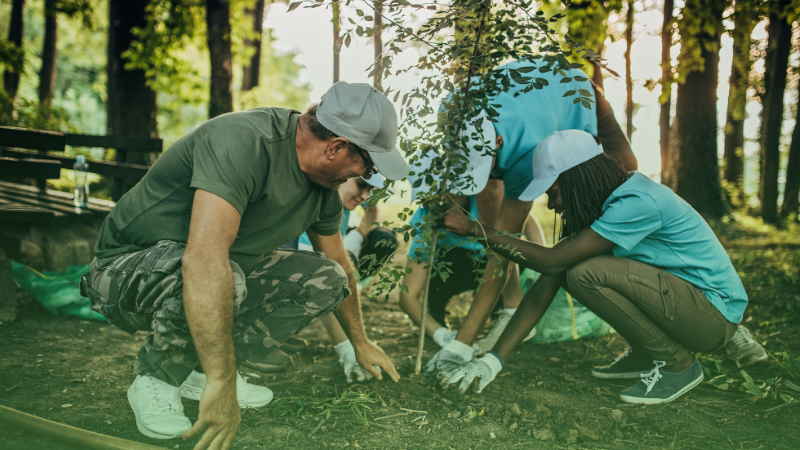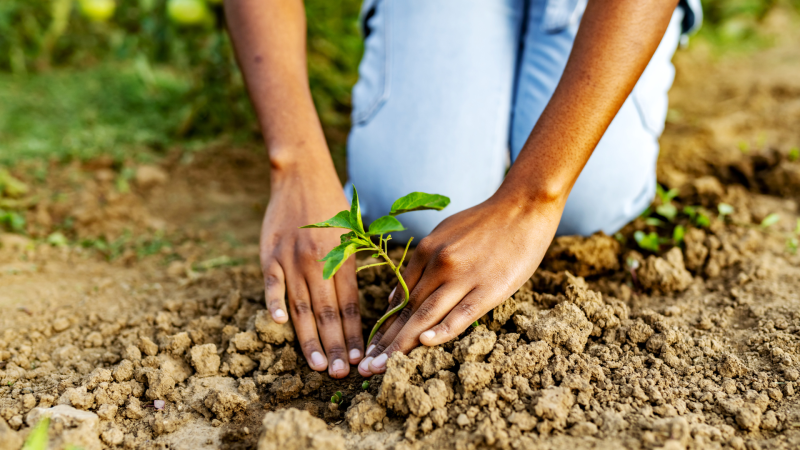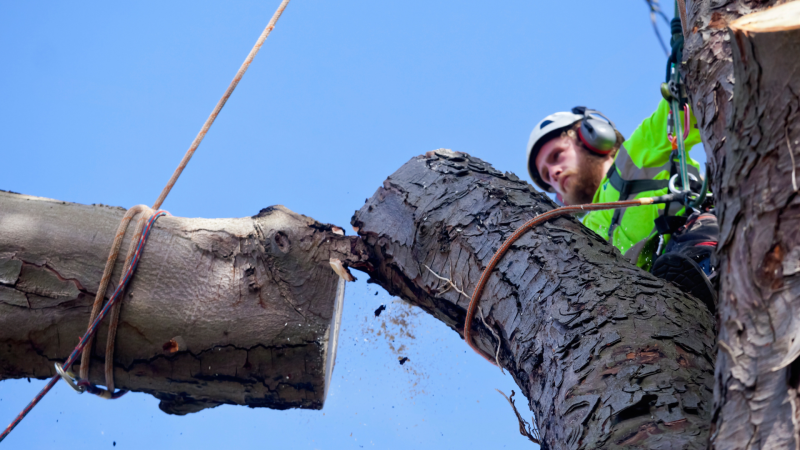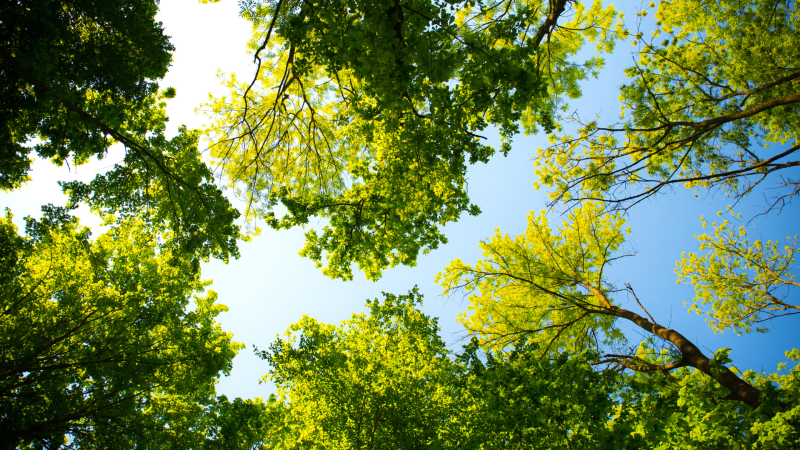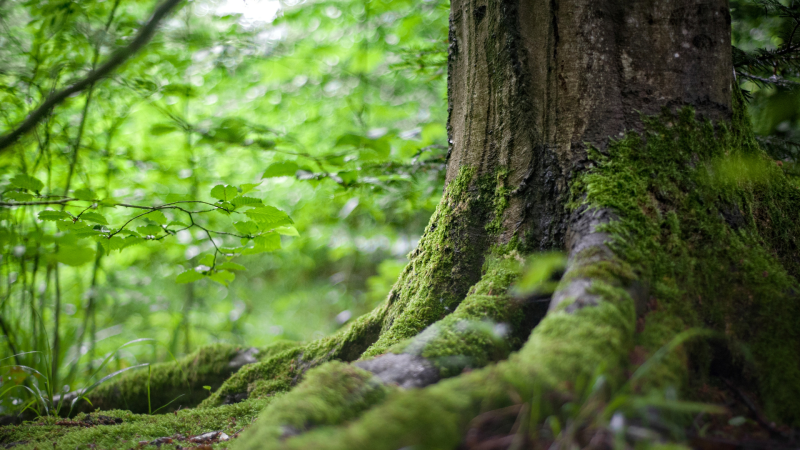Urban Forestry Management
Emergency Response for City Public Trees
To report a damaged City tree that may be causing immediate danger, please call 911. Please note that many damaged City tree related concerns are not immediately actionable by the City.
The City of Alexandria does not maintain or consult on privately owned trees. Please contact a commercial arborist. If this request involves a privately owned tree impacting the public right of way, please submit a request to 'Plan Review, Permit Processing and Other Code Enforcement Inquiries'.
Urban Forestry News
Tree Inspections & Planting Requests for Public Trees
Plans & Studies

The Urban Forestry Section of the Department of Recreation, Parks, and Cultural Activities is responsible for the management of the urban forest on public lands within the City of Alexandria, as well as working with other landowners to plant trees and increase tree canopy cover on private property. There are approximately 20,000 street trees in Alexandria, as well as many thousands more in parks and on the grounds of public facilities (libraries, museums, administrative buildings, and schools). Urban Forest management activities include tree pruning, removal of diseased or dead trees, and planting new or replacement trees.
Urban Forestry - Plan Summary Urban Forestry - Full Master Plan
Tree Canopy
What is a Tree Canopy?
Think of the tree canopy as a giant leafy umbrella created by leaves, branches, and tree parts. It stretches out over the land when we look at it from above. We can calculate how much land gets shaded by trees by measuring it as a percentage.
According to the American Forests organization, urban forests constitute a substantial amount of America’s tree canopy. Over 140 million acres of America’s forests are located in cities and towns. These trees provide essential benefits for humans and improved habitats for urban wildlife.
Canopy Change Assessment
In a proactive effort to align with current best practices and set a robust foundation for measuring tree canopy changes, Alexandria Urban Forestry joined forces with the Spatial Analysis Laboratory at the University of Vermont. Together, they conducted a comprehensive canopy assessment, utilizing established procedures developed in collaboration with the USDA Forest Service. This approach has been widely adopted on national and regional scales with cities like Seattle, New York City, and Chicago.
This canopy change assessment, spanning years 2014 to 2018, harnessed the power of canopy cover metrics, which is the percentage of land area in a city shaded by tree leaves or branches. Canopy cover strongly influences critical tree ecosystem services such as mitigating heat islands and intercepting stormwater. City managers employ these metrics to gain insights into the extent and distribution of their tree canopy, advance strategic objectives, and ensure equitable service provision.
Canopy Cover Assessment
Canopy cover assessments measure urban tree canopy using various methods, each with corresponding degrees of accuracy. These approaches often involve aerial imagery coupled with LiDAR methods. It is up to each manager to determine what level of accuracy is required before a canopy assessment is considered defensible and actionable.
The field of canopy assessment has matured since Alexandria conducted its first assessment in 2001. New, standardized industry best practices have emerged from partnerships between the USDA Forest Service, academia, and municipalities. When applied consistently, these new practices allow for comparison of assessments over time and benchmarking with regional and national peer cities.
LiDAR and aerial imaging captured by regional partners generate a high-quality dataset at a reduced cost. It provides a new benchmark and establishes industry standard procedures to replicate future assessments.
Assessment Results
Notable Trees of Alexandria
What is the Notable Tree Program?
Trees are most often recognized for their environmental benefit to the community. They help maintain clean air and water, reduce soil erosion, and can even lower the cost of energy for residential heating and cooling. The mere presence of trees can also make us feel better about living in the city, bring beauty to an otherwise stark setting, and enhance the value of your property. The Notable Tree Program is designed to recognize the most noteworthy specimens of trees and shrubs growing in Alexandria.
Nominate a Notable Tree
Participate! If you or your neighbor has an outstanding tree or shrub that you think would qualify for inclusion on the register, nominate it. Or if you know of an outstanding specimen on public property, you may nominate it as well. Nominations that are accepted will receive an honorary certificate and be listed on the public register. Having your private tree listed does not take away any of your personal property rights, but we do hope it would inspire you to take good care of it.
What are the criteria for a Notable Tree? To be considered noteworthy for listing, a specimen must be of exceptional size for its species, be an old-age specimen with a known historical connection (person, place, or event), or have ecological importance as a locally rare native species. Generally, only native species are accepted for nomination (see nomination form for exceptions). If nomination is based on size, the tree or shrub will be officially measured by City staff or qualified volunteer using the standards designed by American Forests. All of Alexandria's current state champion trees are listed on the register of the Virginia Big Tree Program.
Alexandria's Registry of Notable Trees
The Registry of Notable Trees is a public document that can be shared and enjoyed by all. In honoring these special trees, we honor not only the past, but also the present and the future. Our hope is that by sharing this information, all residents of the City will better understand the community's stewardship role in preserving both our environment and natural history. City staff periodically review and verify the registry.
Where can I find noteworthy trees in the City? The City of Alexandria was once a natural wonder - from rich river floodplains and swamps to virgin bottomland hardwood forest and tidal marsh. In the past 150 years, urban development and population growth have taken their toll in the form of buildings, parking lots, and roadways. Fast forward to the present day - remaining natural forests are confined to small woodlot-sized parcels or long and narrow stream valleys. Most of our large and historically important trees are now gone. But if you know where to look, in wooded nooks and crannies, or sometimes hidden in plain view in a front or back yard, they are still out there waiting to be discovered and honored.
The best places to search for big trees are along river and stream banks, in cemeteries, church yards, historic properties, and Civil War sites.
In conjunction with the Notable Trees Registry, notable and champion trees can be found using the Map of Alexandria's Champion Trees, which provides tree locations using GPS coordinates, measurements, estimated ages, and historical/cultural significance of our City's trees.
Please note: some of these trees are on private property.
Frequently Asked Questions
Who is responsible for the maintenance of trees in the City of Alexandria?
The City is responsible for the maintenance of any tree located on City of Alexandria-owned property, including the rights-of-way of roads. Landowners, including other government entities and developers, are responsible for trees planted and located on or in the right-of-way of their private properties.
Additionally, there are some neighborhoods where a homeowners association may be responsible for trees in the right-of-way due to agreements made during the site approval process. In circumstances where a tree may be right on the property line, or there may be uncertainty about the boundary between ownerships, additional investigation or survey work may be necessary.
There are trees near my property that need to be trimmed or removed. I believe the trees are on City property. Who is responsible for their maintenance or removal?
Trees growing along the street between the curb and the sidewalk are usually in the public right-of-way and the City's to maintain. You can report a tree you believe requires attention by submitting a 311 service request. Urban Forestry staff will be assigned to inspect the trees and determine if any actions should be required. A copy of the Service Request will be left at the designated address.
How does the City determine whether or not a tree on public property will be pruned or removed?
City Arborists utilize tree care industry standards and their professional judgment on a case-by-case basis regarding what type of maintenance may be appropriate for a tree or if the tree’s removal is warranted. Several factors are considered, including the specific conditions of the tree, its overall health, its location, and the potential risk of damage if it fails. Generally speaking, apparent hazards to the health and safety of our residents receive top priority. City Arborists are trained professionals who evaluate those risks and determine the condition of each tree. Trees will not be pruned or removed simply because they block a view, overhang property lines, or shed leaves or fruits. The Arborist staff can provide information about any tree maintenance decision.
Can I prune or remove trees on City property at my own expense?
No, residents are not permitted to prune or remove trees on City property (or plant new ones) unless approved by the City, per Sec. 6-2-2 of the City Code. Penalties under the Code for violations include a fine not to exceed $500 or imprisonment for up to six (6) months or both. Should the Urban Forestry staff decide that a tree does not meet the criteria for removal, the City will prohibit residents from bearing the cost of tree removal.
A tree is damaging a public sidewalk. Who handles this request?
If a tree or its roots damage a sidewalk, curb, or street, submit a service request to the Department of Transportation and Environmental Services (T&ES).
T&ES staff will investigate the issue and come up with a solution, which may or may not involve the removal of the tree. T&ES will coordinate with Urban Forestry if tree maintenance or removal is necessary.
Who is responsible for pruning & removing trees on private property?
No City ordinances require a property owner to maintain trees or remove dead trees on private property except trees bordering or near public property (City Code section 6-2-21, et seq.). The Urban Forestry section does not provide legal advice or guidance. Please seek professional advice if you have questions about your tree liability.
Trees Overhanging Your Property
In addition, no City ordinances require your neighbor to prune the limbs that overhang your property. You have the right to prune or cut back limbs that overhang your property line at your own expense, provided that the work done does not damage the tree's health or create a hazard. In cases where your neighbor's tree causes damage to your property, they might be liable for the damages or instructed to take corrective action. Each situation is different; we recommend contacting your homeowner’s insurance company or seeking legal advice.
City's Initiative to Trim or Remove Trees Near My Residence
Tree trimming and removal are completed in compliance with the American National Standards Institute Z-133, A300 Standards for Safety and Tree Maintenance Operations, and best management practices adopted by the International Society of Arboriculture and the Tree Care Industry Association.
Tree Trimming
Tree trimming includes crown cleaning, removing deadwood, crossing over or rubbing branches, and correcting weak branch connections. In addition, low limbs that interfere with pedestrian and vehicular traffic, buildings, roofs, or other structures will be removed or cut back. Dead branches, less than an inch in diameter, may not be removed.
Trimming does not include removing all limbs that overhang private property or topping trees to reduce their height.
Visit treesaregood.org for more information on proper tree maintenance.
Tree Removal
The tree removal process occurs in 2-3 steps. Before the removal process, it may be necessary to post "No Parking" signs on or adjacent to the tree to provide adequate room to perform the work safely. No Parking signs may be posted on both sides of a street 1-2 days before the work is complete.
All branches and brush will be removed and chipped during the first step. Logs, trunks, and oversized branches will remain on site until proper removal. Once the removal process is complete, no firewood will remain.
The stump that is left will be ground down as a separate operation. Before grinding the stump, all underground utilities must be marked by the utility locator service. Once the stump removal is complete, soil and organic material from the grinding process will fill the hole and level the area. No additional topsoil or seeding will occur. Depending upon the particular situation and the desire of the adjacent property owner, a new tree may be planted as a replacement.
Is my HOA responsible for the trees on our private streets?
The care and maintenance of the trees along the streets may be the responsibility of a homeowners association or the developer. If you have questions about this, the City Arborist can assist with confirming ownership and responsibility.
A tree fell in my backyard, resulting in yard waste, such as branches & wood. Will the City dispose of it for me?
The Resource Recovery Division of the Dept. of Transportation & Environmental Services (T&ES) will collect and dispose of yard waste, including grass clippings, leaves, branches, and logs. Yard waste is collected separately from household trash. Large items will require a different process for pickup. Some restrictions may apply depending on the type and size of the material.
For more information, visit alexandriava.gov/YardWaste or call 703.746.4311.
Arborist & Tree Maintenance Information
The City’s Urban Forestry Staff are not permitted to provide consulting services or inspections of trees on private property. A qualified private arborist could provide recommendations for the treatment of trees on private property.
The International Society of Arboriculture and the Tree Care Industry Association provides information regarding tree care and selecting an arborist.
Regardless of how you select an arborist to assist you, we strongly recommend that you confirm that the company you are working with is properly insured by requesting a certificate of insurance before signing any contracts or allowing any work to begin.
How can it be determined if a tree is a hazard & likely to fall over?
Despite the diligent care we invest in maintaining the well-being of our trees, it is impossible to ensure that they will never fail during severe weather or even on the calmest days. City Arborists will inspect trees on City property in response to Service Requests submitted online and as part of our ongoing periodic inventory of City trees. A tree risk assessment may even include drilling into the buttress roots and tree trunks to probe for the presence of decay. Our Urban Forestry staff utilizes all pertinent tree risk assessment techniques when evaluating the overall health and potential risks associated with each tree.
Responding to Storm Damage & Other Emergencies
Apart from addressing routine service requests made by residents, the Urban Forestry Team is also one of the City’s primary emergency response groups.
The City’s Solid Waste Division issues guidelines about requirements for removing tree limbs and other debris from storm damage or other conditions. The Urban Forestry Team follows these guidelines alongside the Dept. of Transportation and Environmental Services (T&ES), other City Departments, and private contractors. Additionally, Urban Forestry staff regularly responds to after-hours emergency calls for fallen trees or limbs blocking roads.
Additional Sources of Information
Hire an Arborist Homeowner Tips
For general inquiries, email the Urban Forestry Team. Requests received by email for tree planting and tree inspections, including street trees, will be submitted to 311 and may delay processing.
